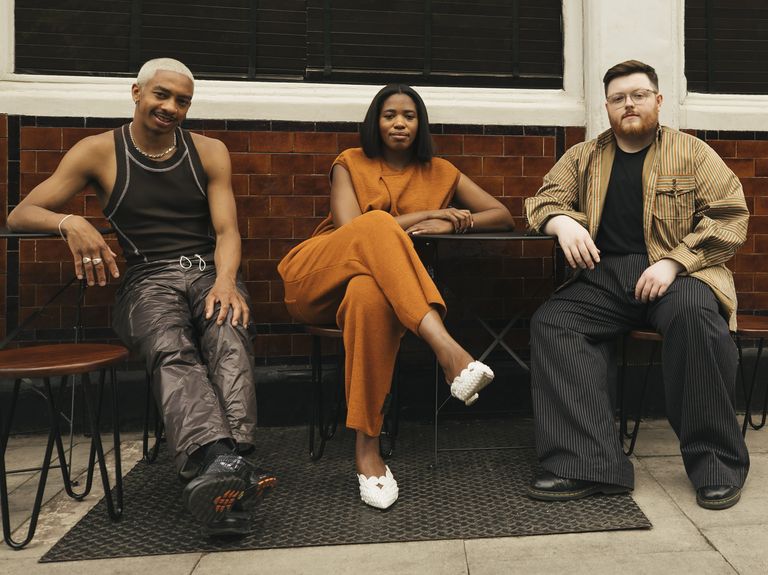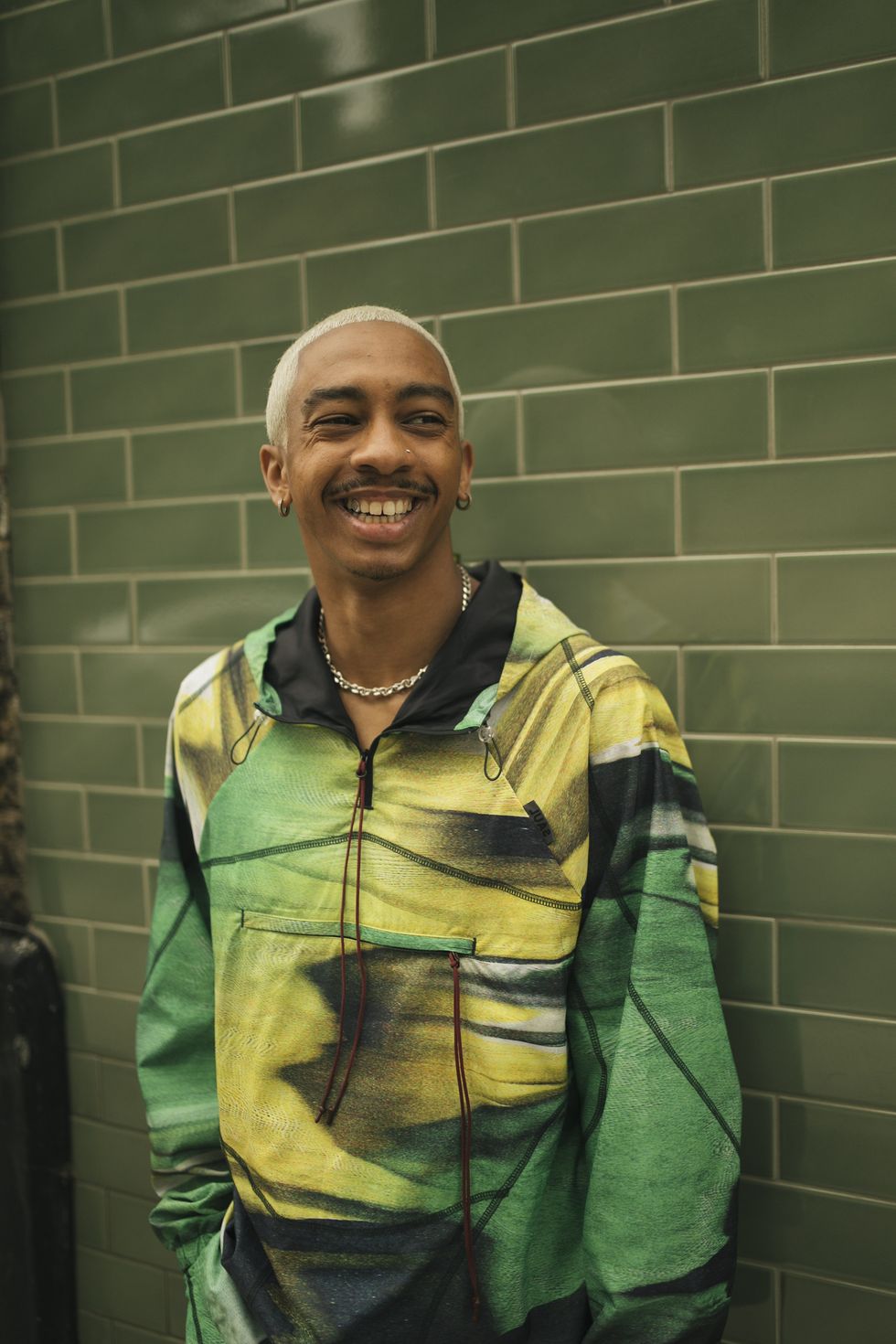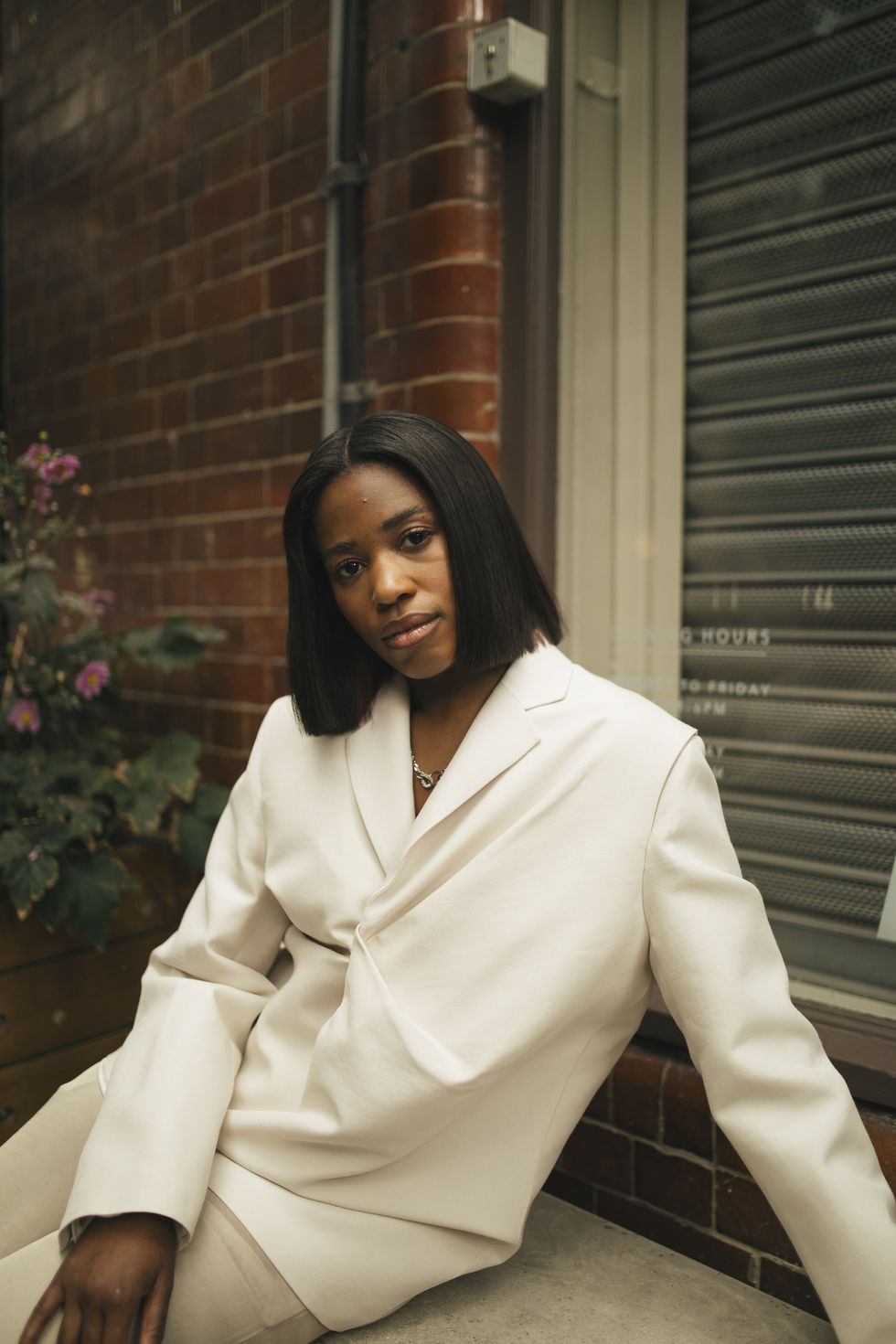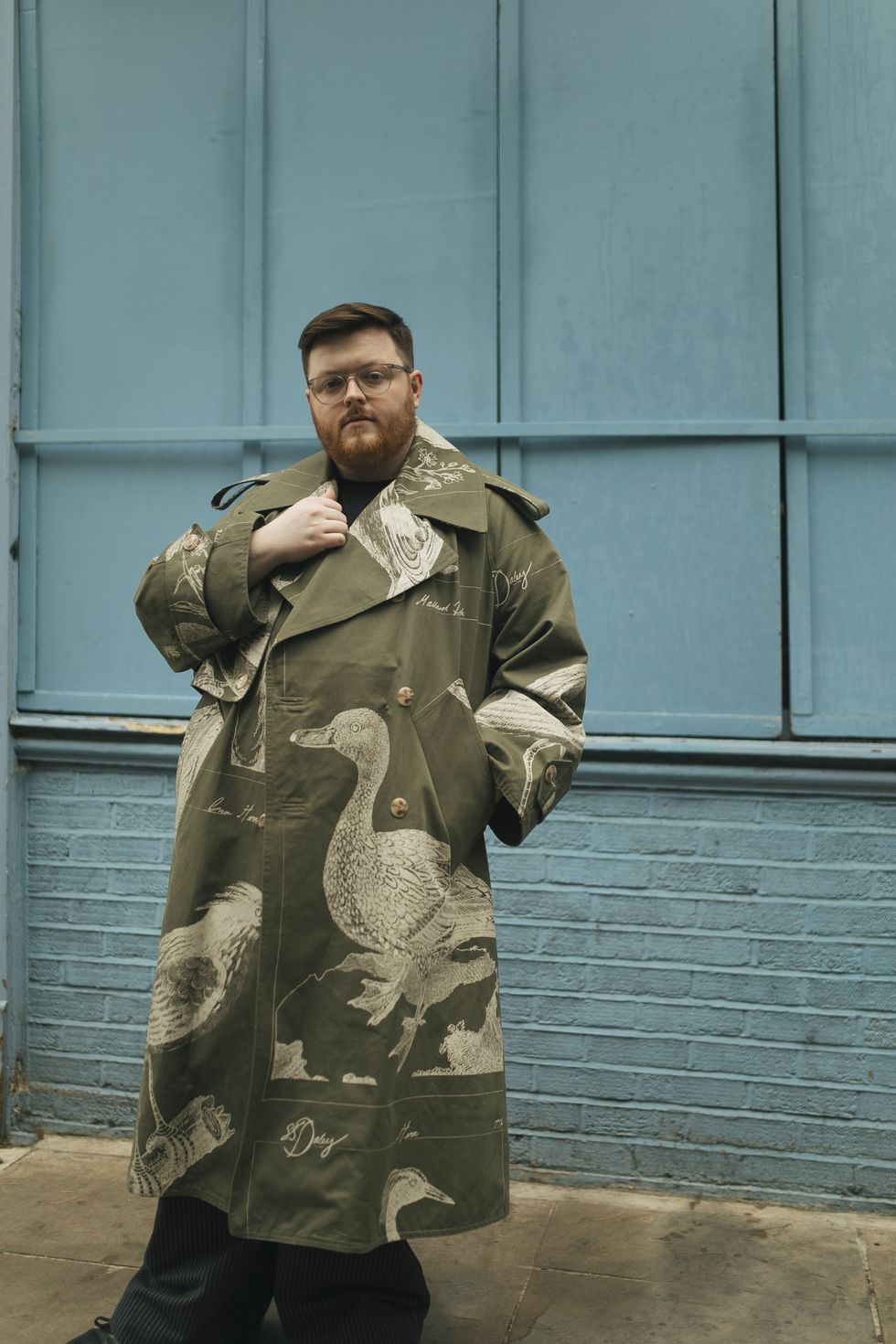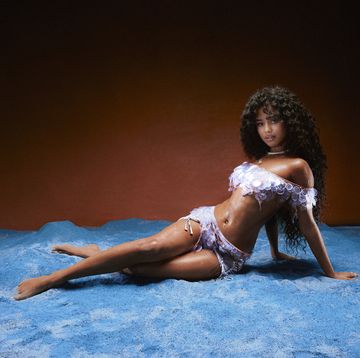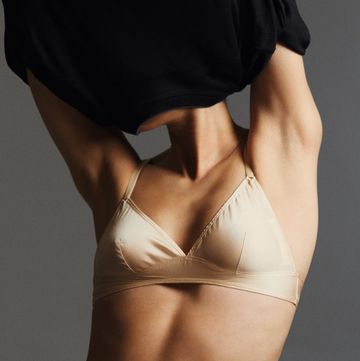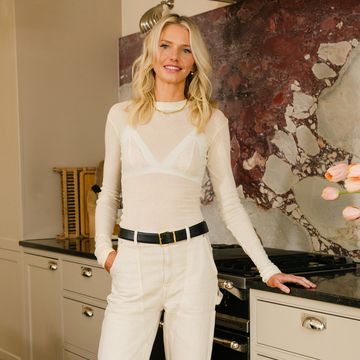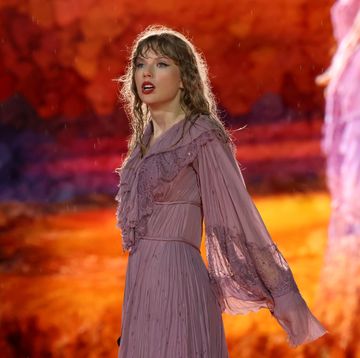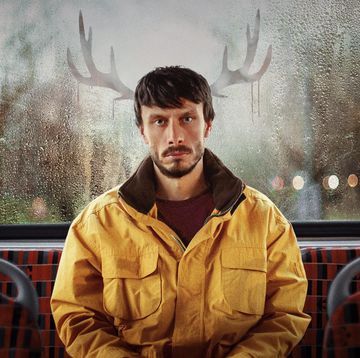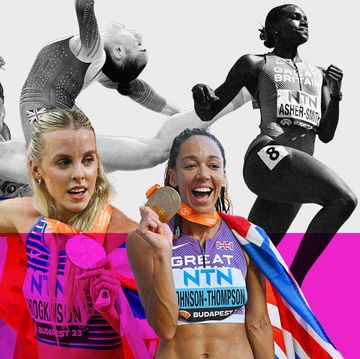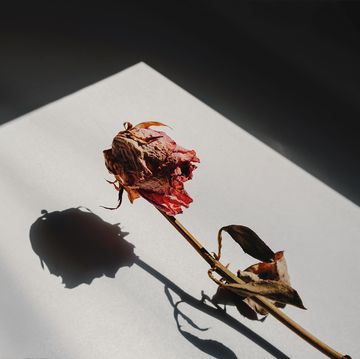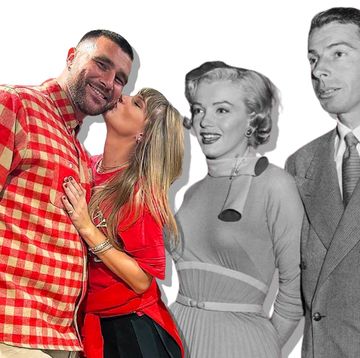‘It’s like a little winners’ table. It’s gorgeous!’ says Liverpudlian Steven Stokey-Daley, sitting down with Londoners Saul Nash and Bianca Saunders. He’s not wrong. All in their mid-to-late-twenties, they are the industry’s most decorated young British designers today. Stokey-Daley recently won the prestigious LVMH Prize for his label SS Daley, while Nash’s eponymous brand was awarded this year’s International Woolmark Prize, as well as the Queen Elizabeth II Award for British Design, which he received from the Duchess of Cambridge (‘She asked a lot of questions, which was amazing. I thought, “Oh, well, hopefully you buy one for your son!”’). And, last year, Saunders picked up the Andam award for her own label, which has meant moving her shows from London to Paris and, along with the prize money, receiving a year of mentoring from the Balenciaga CEO Cédric Charbit.
Their rocketing success has happened in a relatively short time: Saunders held her first show in 2018, Stokey-Daley founded his brand during the pandemic and Nash released his first solo collection in 2021. There are hugs all round as the designers arrive for our roundtable discussion (Nash and Saunders have known each other since their time studying at the Royal College of Art), and compliments are flying – Stokey-Daley is a big fan of Nash’s peroxide hair, and everyone loves Saunders’ white jacket with the ruched fastening from her SS23 collection.
While their creative output is aesthetically very different – from Stokey-Daley’s floral flourishes and knitted vests to Nash’s focus on sportswear and Saunders’ elegant tailoring – the menswear designers of the moment have one thing in common: they are all, to varying degrees, incorporating women’s clothing into their work. Nash is working on an upcoming capsule collection for women, Saunders’ feminine touch stems from using her own body to fit her designs, and Stokey-Daley has just released his AW22 womenswear collection exclusively at Matchesfashion. Cue several more accolades in the pipeline.
We sit down to talk about the dizzying pace of the industry, being kicked off the bus for wearing the ‘wrong’ thing, and why blurring the lines of gendered fashion will never go out of style.
A METEORIC RISE
Steven Stokey-Daley: It’s been crazy [since winning the LVMH Prize]. There’s no time to sit back and celebrate your success. I think we can all agree there’s no downtime in fashion… It’s that work/life balance: you need the life to appreciate the work.
I did have a brief moment of, ‘OK great, wow!’ but then, everything’s still waiting for you at home; life goes on. But I think that’s the pace of the industry.
Saul Nash: It’s humbling to remember that you’re going back home. Somebody once told me that every season we’re creating an achievement: whether we win something or not, the output of the new collection is an achievement. But I’m similar in the sense that I’m not taking time to let it sink in, because everything’s happening so quickly.
Bianca Saunders: Recently I had a moment – because I had this project and the deadline was so short – when I spent the whole weekend working in the studio. It reminded me of being back at university again, and how hard I’ve worked to achieve what I have, and that I do deserve the achievements.
SN: Witnessing your trajectory inspired me as well.
BS: Me and Saul, we’ve been each other’s support systems. We still call each other up now, but it’s become a lot busier so we can’t constantly be on the phone the way we used to be, like, five times a day!
BRANCHING OUT
SSD: The main reason to go into womenswear is that we can’t really ignore the fact that we have quite a strong demand. Now feels like the right time to accommodate that.
Also, I think the conversation today is so much about gender fluidity. That’s not my personal story, and I wouldn’t claim that it is, but I also think it’s acclimatising to the social demand for less structure, less barriers and less labels; it’s nice to have that co-ed direction.
SN: It’s quite interesting when you talk about this through the lens of sportswear or activewear, which I feel has always been quite a unisex sphere of design. I showed my work on men to begin with because I’ve always spoken about my upbringing and my experience as a man. But in my SS22 collection, which was all about uniform and my time at school, I extended that to my best friend, who walked in the show, and I designed a look specifically for her – a top with bound edges and a skirt that had all my signatures in it. It’s never really been the intention to design womenswear as well because I’ve always felt that my clothes were for everybody. This season, when we looked at [the theme of] siblings, it was also important to include the women who are around the men.
BS: People have always asked, ‘When are you going to get womenswear in? When is it coming?’ But I like the idea of women walking to the other side of the room and actually exploring the menswear collection and then making an item their own. When I see an item on women, on men, on non-binary people, it looks completely different.
I try my stuff during fittings, because I’m quite tall. I take how it fits me and then apply it to my menswear, and that’s what adds a feminine touch to it. I like the sex appeal within menswear but then making it elegant.
FASHIONING IDENTITY
SSD: References for my designs have always been rooted in theatre, and so for the first show [SS22] we did a play, devised from our shared experience of school. I collaborated with the National Youth Theatre – I was a member for] four years and had the best time of my life. My whole thing was based on public-school culture: I’m from a small village outside Liverpool, and when I came to London I was confronted by the extent of middle-class wealth and how different educational backgrounds could be. We didn’t tell anyone what was going on. There was no catwalk; it was literally just boys running onto the stage and speaking. Anna Wintour came to the rehearsal. That was a surreal moment, sat there next to her. Luckily, she’s very into theatre.
SN: I’ve been dancing since I was young and studied performance at Central Saint Martins. It’s all about creating a world through gesture and body movement; sometimes theatre comes into it. And when I went to the Royal College of Art, I came with a manifesto to combine dance and fashion. I had no idea how I was going to do it, but then I found sportswear and I felt like a complete person.
I’ve always worn sports clothing but going to the theatre as a child, I felt looked down upon in a tracksuit. I feel that my job as a designer is to reconstruct ideas around what’s right for what occasion. I wear what I want to wear, and it’s not really going to change who I am as a person. That confidence is what I want to give to people.
BS: My Jamaican heritage influences my style and design aesthetic. I’ve always thought that Jamaican men are very well-kept, so I guess I’ve taken aspects of what my family has taught me about dressing and style. I feel like Jamaicans have sex appeal but in a modest way. In terms of music and movement, it’s all about enjoyment, but also being well-dressed, so that balance has influenced me.
People sometimes think that influences need to be literal, but I see things in a more conceptual way. I was born here but my heritage is very strong. It’s my own take on what it means to be Jamaican.
SSD: It’s interesting what you said, Saul, about how you felt you couldn’t wear a tracksuit to the theatre, because it was the same for me but in the opposite way: if I didn’t walk out the door in a North Face jacket and a pair of 110s, I’d be called a f****t in the street or pushed off the bus.
SN: I can really relate to that.
TAKING ON THE CHALLENGES
BS: When the pandemic happened, I remember calling my friend [the stylist] PC Williams and saying, ‘This is the end of me!’ She was like, ‘Get on it with it – things are going to happen, but you go through stages where you readjust and roll with the punches.’ I think that’s how fashion is too: there is something different all the time, but as long as you know you have your audience, who have supported you from the beginning, they will continue the journey.
SN: Our tutor at the RCA always said to flow like water. I’m sure that’s come from Bruce Lee, but the sentiment is really inspirational, because it also created this calm way of assessing things. We were also a smaller team [in the pandemic], so we had more ability to adapt. Navigating that made me realise you can get through anything. Obviously, the British landscape right now is a very interesting one, especially when you’re trying to run a business. Things like there being a new import form to fill out every month.
BS: Oh yeah, that’s the worst!
SN: There are a lot of new challenges. During the pandemic, we didn’t really see the full momentum of fashion, because things actually slowed down. There was a question about whether we would come back with a new vision of what future fashion looks like. And I think some beautiful moments have stuck, like being able to express yourself digitally as well. But it’s also going to be interesting to see how the new political climate is going to affect what it’s like to run a business. A small thing like import tax sounds really mundane, but it actually could really impact the flow of a business, particularly as you get bigger.
SSD: Social media is interesting because, for a lot of us, that was maybe the only platform we had in the pandemic. And since then, I feel like social media is shapeshifting so much. I’m not sure if you guys are looking at all the changes on Instagram? I’ve noticed that I’m only seeing very odd things. I’m not getting anyone else’s posts; just, like, dogs! Social media is constantly changing: you have to really study it to be able to use it.
BS: I always have to block those because, on my brand page, I want to see art; I want to see everyone else I’m following, because that’s what keeps you engaged. Do you have TikTok?
SSD: I don’t use it for my brand yet. I’ve tried but… it’s a lot of work.
SN: You’ve got to create content!
SSD: But who’s got time?
BS: I feel like because they’re so controlled now and people have monetised some of it, it’s harder to enter some social-media platforms: you have to think strategically, it needs to be done in a certain way, it has to be aesthetically pleasing and match the rest of your social channels. It’s quite difficult.
THE CLIMATE QUESTION
BS: I’ve been using deadstock that either certain brands have given to me as a really nice partnership or I’ve received from contacting companies like Nona [LVMH’s deadstock platform], with which I’ve worked with this season. It’s something I would like to continue to do because I’m still at a stage where my orders of fabric aren’t as large as a really big heritage house, so I can still work in that way. But it’ll be interesting to see how I keep reinventing it as I grow.
SN: As an activewear designer, that’s a really important question, because obviously the go-to fabric is synthetic. That’s where the Woolmark Prize has really been significant for me, looking at wool as a 100% biodegradable material.
I think it’s so important to be transparent with your consumer. Where it’s not possible to do certain things, you have to explain why you made that choice. I think understanding material and researching is key when we talk about the conversation around sustainability. But then also to Bianca’s point, you can do the best that you can as the business that you are: there are a lot of advancements that I would love to implement, but maybe my team is not yet at the scale required to take them on.
SSD: I think there’s a lot of onus on young designers, to the extent that I don’t feel massively comfortable with it. Sustainability is at the core of my business, and I think my aesthetic lends itself to that as well: we use a lot of natural fibres and deadstock, and upcycling.
That aside, I think more responsibility should be on bigger designers, because that’s where the change happens. There’s this feeling that when you’re a young person, you can lead the way…
SN: You can do the best you can. Everybody has to do their bit, but we cannot have that pressure to be 100% sustainable.
SSD: I also sometimes think we need to re-evaluate the meaning of sustainability. A lot of people see it as a two-dimensional thing, but I find it more sustainable to put money back into the circular industry. We work with a lot with UK-based artisans and heritage silk weavers, for example. Sustainability is a multi-faceted concept.
SN: Even in terms of output, too – if you create a small, concise and considered collection, it’s more sustainable than just making things frivolously.
BS: I think it has to adjust to the growth of the business. Even at the beginning, I found it quite hard, because I was like, ‘I don’t even know how to make these trousers look good yet…’ [TO SSD] I think what’s great about your brand is that it’s natural. You’re not forcing sustainability, you’re organically slipping it into people’s wardrobes.
SN: I think that should be at the forefront as well, because you want to make things people want to keep. There’s no point making something that’s sustainable but not attractive.
SSD: I also think a job that we can do – and maybe the only thing that we can do as young designers to be sustain-able – is to make garments that are good quality, that last and that people actually want to buy and wear and keep.
WHAT’S NEXT…
BS: My hope for the future is to continue as a lasting brand. Longevity is my main aim.
SN: In the past couple of years, I’ve seen real potential to truly push what I’m doing. I’m somebody who loves to take risks, so I really want to see how I can scale it up in the coming years. But also, from a brand point of view, I love telling stories, and I’m really excited to look at new ways to achieve that. I think that’s what excites me most about sportswear: there are a lot of functional purposes for it as well as design and aesthetic qualities.
SSD: We’re working towards our September show, which is an interesting one and continues to explore a different output in terms of how we show the collection. I’m also finding that our schedules are an interesting thing to navigate as we introduce womenswear. We’re showing in September and February and we’re selling in June and January, so we make sure we get both men’s and women’s markets.
For the future in general, it’s kind of what you said, Bianca: I’ve always felt as a young designer the thing that feels like it could be challenging is longevity, so it’s finding ways to have that.
BS: I think fashion is very like that. I would say it’s probably the worst part of the industry: it’s very throwaway. Every six months there’s something new and people are forgotten.
SN: If you look at the landscape of fashion, there are so many businesses and so many brands, but true longevity is in attracting the people who really believe in what you’re doing. The beauty of fashion is that everyone is so different; I know that the customer for a tailoring brand is not necessarily the customer for me, but maybe they might tap into it. That makes me want to focus on what I’m doing, because we’re all so unique.
This article originally appeared in the October issue of ELLE UK.
